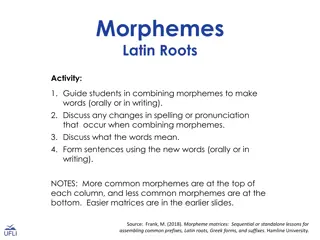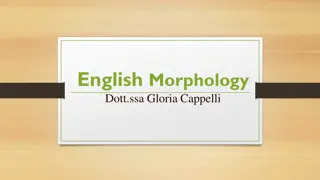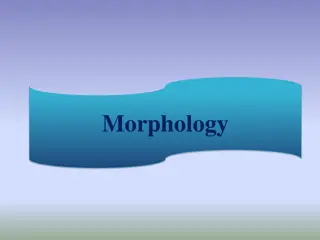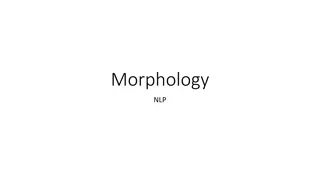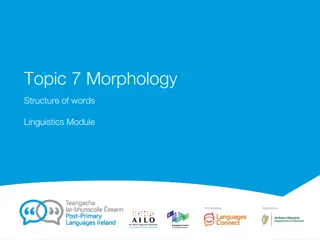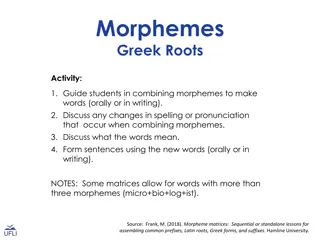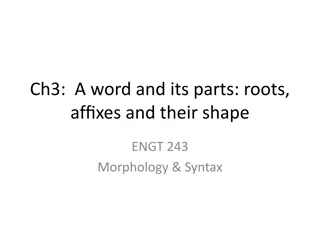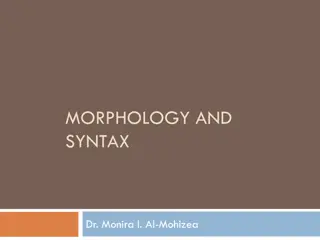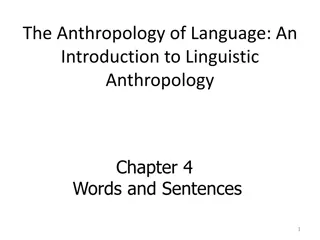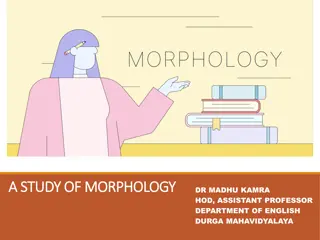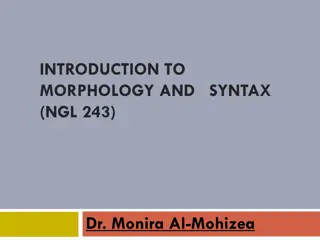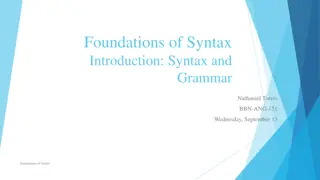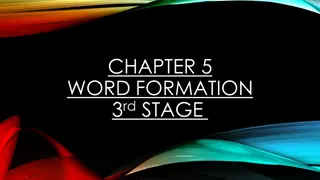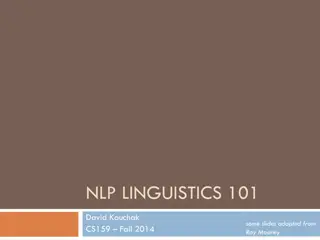Methods of Investigating Foreign and Native Languages
The lecture discusses methods and ways of investigating foreign and native languages, highlighting the importance of understanding language as a system of signs. It delves into various linguistic structures and theories, including Phortunatov's theory of word form and N. Peterson's approach to defin
11 views • 25 slides
Linguistics: Exploring Language Structure and Morphology
Linguistics is the scientific study of language and speech, encompassing branches like phonology, lexicology, and morphology. This field delves into the levels of language structure, such as phonological, morphological, lexical, syntactic, semantical, pragmatical, and stylistical. Scholars began inv
8 views • 7 slides
Exploring Latin Roots through Morpheme Matrices Activity
Engage students in combining Latin morphemes to form words, discussing spelling and pronunciation changes, understanding word meanings, and practicing with sentences. Utilize various morpheme matrices for an interactive learning experience.
0 views • 21 slides
Understanding English Morphology: The Study of Words and Meaning
English Morphology delves into the structure of words, exploring morphemes as the building blocks of linguistic meaning. From free morphemes like "certain" to bound morphemes like "-ly," the discipline uncovers how words are constructed and adapted grammatically. By examining the derivational and in
0 views • 49 slides
Understanding Morphology: Word Structure and Morphemes
Morphology, a branch of linguistics, focuses on word structure by examining morphemes, which are the smallest meaningful units of language. Morphemes can be free or bound, with bound morphemes modifying the meaning of free morphemes through affixes like prefixes and suffixes. Types of affixes includ
1 views • 14 slides
Understanding Morphology in Linguistics
Morphology is a branch of linguistics that explores the structure of words in different languages. It involves dissecting words into meaningful parts called morphemes, such as prefixes and suffixes, to study their grammatical functions. Various distinctions like free vs. bound morphemes and derivati
1 views • 25 slides
Topic 7 Morphology
Delve into the realm of morphology in linguistics, exploring the internal structure of words, how words transform based on grammatical roles, and the processes of word formation through inflectional and derivational morphology. Uncover the various morphological processes and delve into the significa
0 views • 22 slides
Understanding Morphology: The Study of Words and Morphemes
Morphology is the linguistic study of how words are formed and their relationships within a language, analyzing the structure of words, morphemes, prefixes, suffixes, and more. It enriches vocabulary knowledge and aids in understanding word formations.
0 views • 16 slides
Understanding Morphology: The Study of Word Formation
Morphology is the study of how words are formed from smaller units called morphemes. This involves analyzing the structure and meaning of morphemes, whether they are free or bound. By dissecting words like "untied," we can see how morphemes contribute to linguistic patterns and communication.
0 views • 4 slides
Exploring Greek Roots through Morphemes Activity
Guide students in combining Greek morphemes to create words, discussing changes in spelling/pronunciation, word meanings, and forming sentences. Matrices include common Greek roots like bio (life), chrono (time), geo (earth), and more.
0 views • 9 slides
Understanding Morphology: Roots, Affixes, and Shape of Words
This chapter delves into the study of morphology, focusing on morphemes as the building blocks of words. It discusses the characteristics of morphemes, their importance in determining word meaning, and how they contribute to the structure of complex words. By examining examples like "helpfulness" an
5 views • 38 slides
Understanding Changes in Aspect: Workshop Highlights by Elly van Gelderen
Explore the systematic changes in verb meaning due to aspect and theta-roles, the influence of lexical and grammatical aspect on each other, and the significance of telic, durative, and stative aspects in language. Discover insights on children's early awareness of aspectual verb classes and their c
0 views • 77 slides
Decoding English Words: From Syllables to Morphemes
Explore the evolution of English language complexity due to historical invasions, the impact on orthography, and the significance of morphophonemic patterns in decoding, spelling, and understanding English words using Latin and Greek morphemes.
1 views • 22 slides
Understanding Morphology and Syntax in English Language
This content explores morphology and syntax in English language, covering topics like conversion, compounding, and the formation of words through various linguistic processes. It delves into examples of verb-noun conversions, productive word formation methods, and compound words. The discussion also
0 views • 27 slides
Language Development in Children: Morphology and Syntax Acquisition
Children's language acquisition process involves developing morphology by adding inflectional morphemes to nouns and verbs, such as "-ing" and "-s" for plurals. Overgeneralization occurs as children apply rules, leading to expressions like "foots" and "mens". Additionally, irregular plurals and poss
0 views • 13 slides
The Anthropology of Language: Words and Sentences Overview
Explore the anatomy of language from morphology to syntax, delving into the structure of words, morphemes, and sentences. Understand the analysis of morphemes and their arrangements, the descriptions of bases forming words, kinds of bases like roots and stems, and creating a language from base forms
0 views • 31 slides
Understanding Morphology in Linguistics
Morphology in linguistics involves the study of word structure, formation, and morphemes, which are the smallest meaningful units in language. Words can be broken down into morphemes, with some being monomorphemic (e.g., "pig") and others polymorphemic (e.g., "foolishness"). The concept of morphemes
0 views • 25 slides
A Study of Morphology: Insights into Word Formation and Structure
Morphology, a field of linguistics originating from Greek words, delves into the study of word structure. It explores types of morphemes, branches of morphology, and processes like affixation and vowel change. The creation of new words and changes in existing ones through grammatical functions are a
0 views • 9 slides
Understanding Morphology and Syntax with Dr. Monira Al-Mohizea
Explore the fascinating realm of morphology and syntax in language with Dr. Monira Al-Mohizea's insightful guide. Learn about the internal structure of words, morphemes, and the aim of morphology to uncover subconscious knowledge. Delve into discussions on what constitutes a word and various definit
0 views • 19 slides
Understanding the Foundations of Syntax in Language
Delve into the basics of syntax and grammar, exploring the essence of language, syntax rules, morphemes, and morphemic decomposition. Discover how syntax shapes meaningful communication and learn to identify morphemes in English words.
1 views • 17 slides
Understanding Child Language Acquisition: Grammar Development Insights
Explore the intricacies of child language acquisition focusing on grammar development. Delve into concepts like bound morphemes, free morphemes, inflectional morphology, derivational morphology, word classes, and Roger Brown's meaning relations. Gain insights into lexical and grammatical stages of d
1 views • 11 slides
Understanding English Phrase Structure: Analysis and Examples
Explore the morphosyntactic analysis of English phrases and the grammatical hierarchy, delving into sentence constituents, clauses, phrases, words, and morphemes. Learn about different types of phrases, their structures, and elements like modifiers, headwords, and grammatical markers, with illustrat
0 views • 30 slides
Understanding the Morphosyntactic Analysis of English Sentences with Prof. John Corbett
Delve into the intricacies of sentence constituents, phrase structure, clause functions, and morphemes in English sentences as explained by Prof. John Corbett, an International Fellow at USP-CAPES. Explore how phrases combine and relate to each other, and learn about the structure of clauses and the
0 views • 30 slides
Understanding Lexical Categories in Morphology
Explore the world of lexical categories, morphology, and affixes to enhance your grasp of grammar concepts. Dive into the definitions of nouns, verbs, adjectives, prepositions, pronouns, articles, conjunctions, and adverbs. Learn about affixes such as prefixes, suffixes, infixes, and circumfixes, an
0 views • 12 slides
Comprehensive Guide to Grammar: Morphology, Word Classes, Clauses, and More
Explore the fascinating world of grammar with insights into morphology, word classes, clauses, and sentence elements. Unravel the complexities of free and bound morphemes, learn about different word classes like nouns, and delve into the hierarchy of grammar. Discover the diverse aspects of language
0 views • 40 slides
Exploring Word Formation: Etymology, Borrowing, Compounding, and More
Explore various processes of word formation including etymology, borrowing, compounding, blending, clipping, backformation, conversion, acronyms, derivation, prefixes, suffixes, and infixes. Learn about the origins and history of words, the creation of new terms, and how different morphemes are adde
0 views • 8 slides
Understanding Morphology: Building Blocks of Language
Morphology is the study of the internal structure of words and how they are formed from morphemes, such as stems and affixes. By analyzing morphology, we can understand how words are created and related to each other, enabling us to generalize, obtain additional information, and handle new words eff
1 views • 49 slides
Understanding Morphology in Linguistics
Morphology is a branch of linguistics that focuses on word structure and the smallest meaningful units of language known as morphemes. It delves into the decomposition of words and the classification of morphemes into bound and free categories. Bound morphemes, such as prefixes and suffixes, modify
0 views • 16 slides
Exploring Language, Decision-Making, and Consumer Psychology
Delve into the intricate relationship between language and decision-making, discover how advertising utilizes language to influence consumer behavior, and examine the impact of semantics and the framing effect on our perceptions. Understand the elements of language, such as phonemes, morphemes, and
0 views • 76 slides


